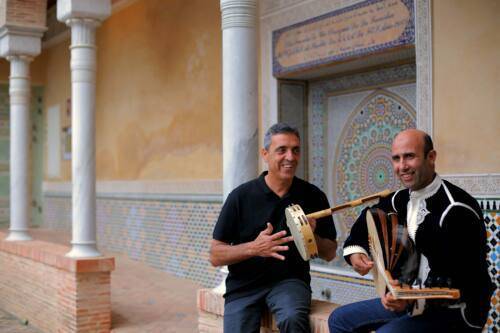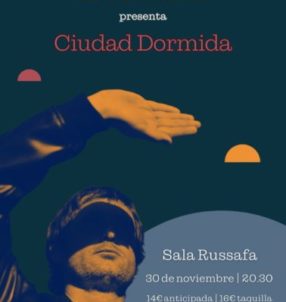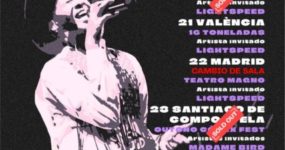24/7 VALENCIA: Tell us about your Valencian roots and your first experiences with music from your land…
PEP BOTIFARRA:My first contact with traditional Valencian music was via my family. Most specifically, my grandmother Otília Borredà who was from the town of Benigànim. She knew so many songs and popular sayings and as I practically grew up with her, I learnt a lot from her. But as it happens, due to my youth, I didn’t pay that much attention to them then. Now I do regret not having listened to my grandmother more.
Years after, at the age of 15 or 16, I began singing “albaes” in my city, Xàtiva. I joined the ‘Grup Sarau’, a travelling group of the Costera region. I went with them at weekends, through all of the towns of my area and we made recordings of the older people who recorded traditional songs. We recorded on cassette tapes, which are now digitalized. In the future, we are planning to have them available to anyone who wants to listen to the recordings.
For many years, I was collaborating with many groups until 2006, when my best friend Emili Vera encouraged me to record my first solo album ‘Si em pose a cantar cançons’ (Cambra Records, 2006) And since that moment, my life has been non-stop concerts.
What is the connection between Valencia and Arabic culture? The land of Valencia, due to its geographic situation halfway between the shores of the North and the South of the Mediterranean and by its history (the Muslim presence lasted centuries) has influences from the music of North Africa. Maybe what most distinguishes them are the “work songs.” However, they also have characteristics similar to other Mediterranean countries such as Italy, Greece and more. Also, I have to say that before knowing Ahmed Touzani (voice, violin, oud) and recording this album (between one and the other 10 years have passed) I have always loved the music of North Africa and I often listen to it.
What is the concept of the album: ‘De banda a banda del Mediterrani’? The idea is to demonstrate the similarities with both types of music. In its elaboration, we have left enough room for spontaneity, joining those popular pieces that Ahmed and I know and they have some obvious resemblances. Also, in these times of xenophobia and the refugee crisis we want to send out a message of brotherhood to counteract messages of hate and fear.
Could you tell us something about each song?
CANT DE BATRE DE JOSÉ CRUAÑES. José Cruañes was from Jávea. I learned this song via a recording from the 1950s. Of all the songs in the album, this is the only one I had recorded before and it also appears on my first album.
LA XITXARRA. This is a song from the south of Valencia (in this album there are a lot). Specifically, it is a ‘jota’ from the pueblo of Biar.
L’U DE BIAR. Another song of Biar, in this case an “u”, or in other words, a fandango. Of the three verses, two are in Spanish and the other is Valencian.
GERINELDO. It is a widely known romantic tale in all of the Iberian Peninsula, Portugal included. My grandmother sang me a version. Ahmed sings a version of the romance from Tangiers.
SEGIDILLES DE LA FOIA. They are from the Foia de Castalla, again in the south of Valencia. Ahmed sings this Djibouli song.
CANT DE BATRE DE ROTGLÀ i CORBERÀ. This work song was taught to me by my Uncle Adrià. It is another bilingual subject of Valencian/ Castilian. Ahmed sings a Moroccan song from the city of Meknes.
JOTA DE LES VENTES. It is from the town of Moixent. Here we have a union of traditional lyrics with new ones from Joan Moixino, that refers to the brotherhood between towns.
LA PERXELERA. Traditionally, this is in the ‘petenera’ style from the towns of Palma and Ador, near Gandía.
CANT DE BATRE DEL GENOVÉS. The third and last work song on the album. These songs were formed in the fields without instrumental accompaniment. They were constructed in the countryside during the seasonal months of August or September, whilst working with wheat or rice. I learnt it from my Aunt Leonor.
EL COPEO D’ONTINYENT. This ‘copeo’ is a traditional rhythm of Mallorca (the Mallorquins repopulated some Valencian areas in the 17th century). This version is from Ontinyent.
L’U DEL TIO RITO. Another fandango. The singing is by Ahmed (Ya-Rayah) is a very popular subject in Algeria and other countries and talks about the problems of immigrants.
LA TARARA. It’s the most well-known song here, but also in Tangiers. When we went to play there, in April of 2017, the people knew the song already.
Tell us something about the other musicians in the band A majority of the members in this new group had never worked together before. Xus Belda y Aitor Sáez are two young percussionists but they already have a lot of experience. The bassist Oscar Cortés is also a veteran of this type of music, as is the ‘dulzainero’ Ricard Soriano. Héctor Peropadre plays the lute, accordion, dulzania and tarota. Even though he is also young, he has a lot of experience in the world of traditional music; he’s well-known for his time in the group ‘Aspencat’. The trumpeter and trombonist Tony Molina has played, and continues to play, with some of the biggest international music stars. And finally, the three musicians that have accompanied me for years: Vicent Carrasco is a big traditional music veteran and stands out especially with his guitar playing. Juanra Martí is a ‘dulzainero’ with an impressive curriculum. Aside from playing strings, Pere Ródenas is the album’s producer and arranger of all the songs.
Interview by Owl
(Translation by Stephanie Penn)
Photo by Juanjo Company
More info at https://pepgimenobotifarra.wordpress.com/agenda/
Related Post
This site uses Akismet to reduce spam. Learn how your comment data is processed.

























Leave a comment